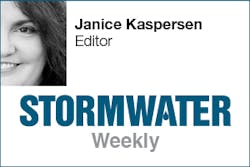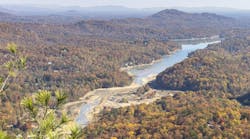
We’ve become much better in recent years at predicting storms and other weather events. Even for hurricanes, which can change intensity and direction unpredictably, scientists can give a fairly good idea of what will happen nearly a week before it does, thanks to better satellite data and more sophisticated models, and NOAA makes that information available in real time. This article from Stormwater looks at how scientists in Taiwan and elsewhere are using new techniques to predict local rainfall patterns during massive storms like hurricanes—or typhoons, as they’re more commonly known in the Pacific.
Now researchers are looking at ocean water temperatures to make an even more long-term weather prediction. Specific temperature patterns in the northern Pacific Ocean can show that a heat wave is likely to occur in the Midwestern or Eastern US as much as 50 days later. That’s weeks beyond what we’ve been able to predict before.
Why is that important? Hurricanes and floods aren’t the only weather events that can kill; on average more than 600 people die each year in the US from heat-related causes, and even more during especially intense heat waves. Heat waves also take a toll on crops and livestock. With more time to plan, urban officials could set up more shelters or cooling centers, and social workers could arrange to check on homebound, chronically ill people, who tend to be hit hard by extreme temperatures, especially in parts of the country where air conditioning is less common. Farmers could arrange shade for animals and extra irrigation.
A study on the phenomenon was recently published in Nature Geoscience and is summarized here. Scientists examined more than three decades of data to chart the correlation between ocean temperatures and inland heat waves. Although they aren’t sure exactly what the connection is between the two, one of the study’s authors theorizes that ocean temperatures affect the jet stream, which in turn causes high-pressure air to settle over parts of the US.
Upcoming Webinars From Forester University
There is still time to register and earn PDH or CEU credits. Click here for a full list of upcoming webinars and webcasts.
Free Webinar – Wednesday, March 30
Using Software for Successful Project Design
Are you up-to-date on the latest design and assessment programs?
Join Matthew Welch, CESSWI, for this free webinar sponsored by Profile Products to explore the latest in project design software; its parameters, calculations, and applications; and how you can put it to work at your sites coupled with the Five Fundamentals to maximize your erosion/sediment control and revegetation success.
Click here for more information and to register.
Thursday, April 7
Sidewalks & Recreational Trails: Design, Evaluation, and Management
Did you know that there are more than 1 million miles of sidewalk in North America, and 15-20% need repairs…estimated at $15 billion? Join David Hein to explore the latest innovation in sidewalks and recreation trail design, construction, and maintenance, and how you can apply these techniques to your sidewalks and trails to extend their lifetime, meet compliance, and reduce your costs.
Click here for more information and to register.
April 12 and 14
Hydraulics 101 (for Those Who Skipped It in College)
At a loss when hydraulic engineers start talking? Join former IECA president David Williams to learn to “talk the talk” and better understand your hydraulic engineers and their reports when they’re talking in terms of unsteady flow, allowable sheer stress, Manning’s “n,” etc. In this second part of our Surface Water Master Class series, Williams presents a live and on-demand two-session webinar, where he’ll discuss the base concepts, terms, and analyses behind hydraulics and hydraulic studies, as well as advanced topics (e.g., hydraulic scour of structures, weirs, culverts, hydraulic grade control, and bank stabilization), and how all of these are essential for effective hydraulic design.
Click here for more information and to register.
April 20 – May 26
Sediment & Erosion Control for Construction Sites Master Class Series
Join industry experts Jerald Fifield and Tina Evans for a comprehensive, six-part live and on-demand master class and workshop series exploring the ins and outs of effective sediment and erosion control plan design and review for construction sites. Enjoy six online lectures and Q&A sessions and three interactive workshops presented by Fifield and Evans, delving into Fifield’s best-selling third edition of Designing and Reviewing Effective Sediment and Erosion Control Plans (included in your Master Class Series package).
Click here for more information and to register.
Thursday, May 15
Stormwater Treatment Maintenance: What Works and How to Do It
A major struggle for all stormwater managers is developing an adequate stormwater treatment maintenance program…on a budget. Join returning speaker and author Andrew Erickson to explore the best practices in stormwater treatment maintenance design, implementation, and budgeting, as well as real-world data and examples of what works (and doesn’t).
Click here for more information and to register.
About the Author
Janice Kaspersen
Janice Kaspersen is the former editor of Erosion Control and Stormwater magazines.

